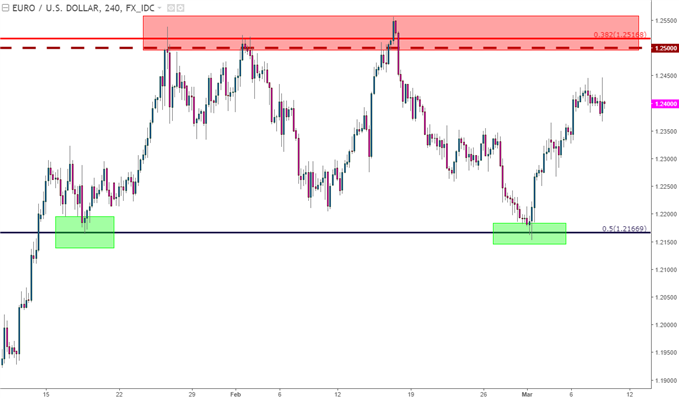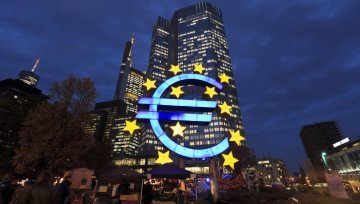Talking Points:
- This morning’s ECB rate decision saw little change in actual policy, but we did see a tweak to the statement that indicates a more optimistic, slightly less-dovish European Central Bank. This created quick moves of strength in both EUR/USD and EUR/JPY; but that strength quickly dissipated as the accompanying press conference began with Mario Draghi at 8:30 AM ET.
- For those looking to fade the Euro with expectations of bearish continuation following this morning’s post-ECB reversal, EUR/JPY may be more attractive than EUR/USD. Both pairs are investigated below.
- Are you looking to improve your trading approach? Check out Traits of Successful Traders. And if you’re looking for an introductory primer to the Forex market, check out our New to FX Guide.
If you’re looking for longer-term analysis on US Stocks, the Euro or the U.S. Dollar, click here for our Trading Guides.
EUR/USD Rally on the Statement, Reverse on the Presser
There were few expectations for any significant change at this morning’s European Central Bank rate decision. So this is probably why such a small, subtle alteration has kick-started some volatile price action in the single currency. This morning’s statement out of the ECB removed a key phrase that had previously alluded to the possibility of more QE should the economic back-drop worsen. The exact phrase was: “If the outlook becomes less favourable, or if financial conditions become inconsistent with further progress towards a sustained adjustment in the path of inflation, the Governing Council stands ready to increase the Asset Purchase Programme (APP) in terms of size and/or duration.”
This removal of this phrase was the bulk of the change in this morning’s statement; at least from what was seen at the January rate decision. And subtle as it may be, the near-immediate response in the Euro was a fast-move higher as EUR/USD perched above 1.2440 shortly after the release. Much of this strength was reversed after the accompanying press conference began at 8:30 AM ET, leaving us close to where we had started.
EUR/USD One-Minute Chart: Rip on the Statement, Dip on the Press Conference (Red)

Chart prepared by James Stanley
EUR/JPY also rallied, albeit less enthusiastically from what can be seen in EUR/USD. EUR/JPY is currently finding sellers in a longer-term zone of prior support. The level of 132.05 is the 50% retracement of the 2014-2016 major move in the pair, and this price had helped to set support on multiple occasions as we closed out last year. More recently, this area has helped to produce resistance, and with a revisit to this zone, the door can open for short-side plays; making this one of the more attractive areas for those that might want to look to fade this morning’s Euro-strength.
EUR/JPY Daily Chart: Prior Support Zone Helping to Set Near-Term Resistance

Chart prepared by James Stanley
What Does This Mean for the Euro?
The removal of the above phrase seems largely symbolic from here. Would the ECB actually avoid investigating an increase in QE over the next few months if a nasty bout of risk aversion develops, solely because they removed this phrase from the statement? Probably not, and that option will likely remain on the table for the foreseeable future. Also indicating a still-dovish posture is that the ECB made no increases to 2018 inflation expectations, and the bank will continue to reinvest portfolio dividends beyond the QE program’s current end-date of September, 2018.
But, for a bank that’s largely tried to avoid the topic of rate hikes or tighter policy or even stimulus-taper altogether, this morning’s change makes for an important signal to global markets that the European Central Bank is getting a bit more optimistic on forward-looking market conditions. The big question now is whether the strength in the Euro over the past year can dent inflation to the degree that the ECB can continue with a passive approach as we head towards September, even if they are a bit more optimistic.
Longer-Term Euro Outlook
As we came into March, it appeared as though there was a legitimate chance of a bearish move to develop in EUR/USD, as prices had fallen by almost 400 pips within two weeks. But support came-in off of a Fibonacci retracement that had helped to bring out buyers in January, and since then bulls have remained in-control as EUR/USD hard-charges towards that 1.2500 psychological level.
The big question there is if we can overtake 1.2500. This would be the fourth attempt already in 2018, and each of which has failed thus far. Of note – we did get some additional breach on the last attempt to take out 1.2500, as the high came-in at 1.2556, eclipsing the previous high from the prior failed breakout at 1.2538. This may be showing a waning degree of resistance around this area, and if we do see another test of this level, the bearish response may show to a lesser degree.
EUR/USD Four-Hour Chart: Trend Turbulence at 1.2500

Chart prepared by James Stanley
EUR/JPY Remains in the Crosshairs with BoJ Tonight
EUR/JPY isn’t done with rate decisions just yet, as a Bank of Japan interest rate decision later tonight will keep the pair in-focus. In Japan, we’re seeing something similar to what was witnessed in the Euro-Zone last year, where a full-throttle QE program is finally beginning to run into some consistency in growth along with a rise in inflation. Just a couple of weeks ago we got inflation data out of Japan for January, and this came-in at a 34-month high. To date, the BoJ has shown no willingness to get less-dovish, and again this is similar to the scenario around the Euro last year as the ECB remained loose and passive, only now starting to pose subtle changes to their statement. But – like the Euro’s strength last year, the Japanese Yen has found bids as those inflation numbers have ticked-higher, indicating that market participants are warming to the idea of a less-dovish BoJ, at some point in the future.
USD/JPY Weekly Chart: Yen-Strength Shows in 2018 as Japanese Inflation Grows

Chart prepared by James Stanley
EUR/JPY makes for an interesting environment around these themes. Euro strength was rather pervasive in the pair all the way into February at which point a bearish reversal developed that still hasn’t ended. This comes along with a change in the tonality around the Japanese Yen, which had previously been a fairly weak currency on the basis that the BoJ was nowhere near their own stimulus exit. But – as inflation has grown, so have those expectations for a less-dovish shift out of the Bank of Japan.
Tonight brings the first BoJ rate decision after that 34-month high inflationary print, and if the BoJ isn’t able to re-energize the theme of Yen-weakness, the short-side of EUR/JPY could remain attractive in the near-term.
To read more:
Are you looking for longer-term analysis on the Euro, the British Pound or the U.S. Dollar? Our DailyFX Forecasts for Q1 have a section for each major currency, and we also offer a plethora of resources on our EUR/USD, GBP/USD, USD/JPY, AUD/USD and U.S. Dollar pages. Traders can also stay up with near-term positioning via our IG Client Sentiment Indicator.
--- Written by James Stanley, Strategist for DailyFX.com
To receive James Stanley’s analysis directly via email, please SIGN UP HERE
Contact and follow James on Twitter: @JStanleyFX






